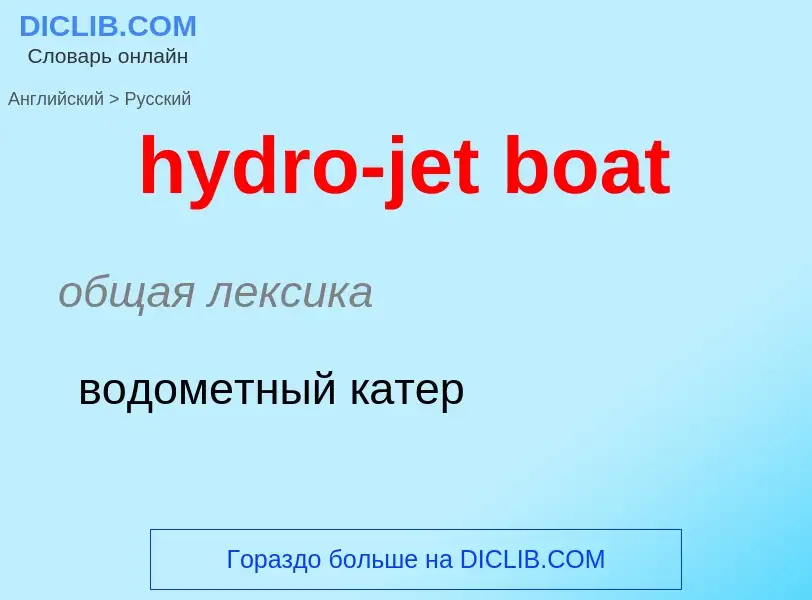Translation and analysis of words by ChatGPT artificial intelligence
On this page you can get a detailed analysis of a word or phrase, produced by the best artificial intelligence technology to date:
- how the word is used
- frequency of use
- it is used more often in oral or written speech
- word translation options
- usage examples (several phrases with translation)
- etymology
hydro-jet boat - translation to russian
общая лексика
водометный катер
общая лексика
гидроаппарат
гидрореактивный
Definition
Wikipedia

A jetboat is a boat propelled by a jet of water ejected from the back of the craft. Unlike a powerboat or motorboat that uses an external propeller in the water below or behind the boat, a jetboat draws the water from under the boat through an intake and into a pump-jet inside the boat, before expelling it through a nozzle at the stern.
The modern jetboat was developed by New Zealand engineer Sir William Hamilton in the mid-1950s. His goal was a boat to run up the fast-flowing rivers of New Zealand that were too shallow for propellers.
Previous attempts at waterjet propulsion had very short lifetimes, generally due to the inefficient design of the units and the fact that they offered few advantages over conventional propellers. Unlike these previous waterjet developments, such as Campini's and the Hanley Hydrojet, Hamilton had a specific need for a propulsion system to operate in very shallow water, and the waterjet proved to be the ideal solution. The popularity of the jet unit and jetboat increased rapidly. It was found the waterjet was better than propellers for a wide range of vessel types, and waterjets are now used widely for many high-speed vessels including passenger ferries, rescue craft, patrol boats and offshore supply vessels.
Jetboats are highly manoeuvrable, and many can be reversed from full speed and brought to a stop within little more than their own length, in a manoeuvre known as a "crash stop". The well known Hamilton turn or "jet spin" is a high-speed manoeuvre where the boat's engine throttle is cut, the steering is turned sharply and the throttle opened again, causing the boat to spin quickly around with a large spray of water.
There is no engineering limit to the size of jetboats, though whether they are useful depends on the type of application. Classic prop-drives are generally more efficient and economical at low speeds, up to about 20 knots (37 km/h; 23 mph), but as boat speed increases, the extra hull resistance generated by struts, rudders, shafts and so on means waterjets are more efficient up to 50 knots (93 km/h; 58 mph). For very large propellers turning at slow speeds, such as in tugboats, the equivalent size waterjet would be too big to be practical. The vast majority of waterjet units are therefore installed in high-speed vessels and in situations where shallow draught, maneuverability, and load flexibility are the main concerns.
The biggest jet-driven vessels are found in military use and the high-speed passenger and car ferry industry. South Africa's Valour-class frigates (approximately 120 metres or 390 feet long) and the 127 metres (417 ft) long United States Littoral Combat Ship are among the biggest jet-propelled vessels as of 2020. Even these vessels are capable of performing "crash stops".


![hydroplaning]] position. hydroplaning]] position.](https://commons.wikimedia.org/wiki/Special:FilePath/EFV hydroplaning.jpg?width=200)
![Shotover Canyon]] in [[New Zealand]], the country for which jetboats were originally invented. Shotover Canyon]] in [[New Zealand]], the country for which jetboats were originally invented.](https://commons.wikimedia.org/wiki/Special:FilePath/Shotover Jet, Jet Boating the Shotover River Canyons, Queenstown, New Zealand.jpg?width=200)
![A jetboat powers through the rapids of [[Niagara Gorge]], near [[Niagara Falls]]. A jetboat powers through the rapids of [[Niagara Gorge]], near [[Niagara Falls]].](https://commons.wikimedia.org/wiki/Special:FilePath/Whirlpool Jet Boat Tours in Devil's Hole Rapids in Niagara River Gorge.jpg?width=200)
![''Discovery'']] ''Discovery'']]](https://commons.wikimedia.org/wiki/Special:FilePath/Waterjet on HSS Discovery.jpg?width=200)
